SHAOLIN WAHNAM TRAINING PROCEDURES
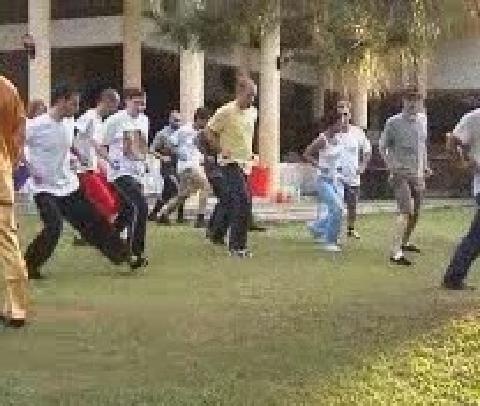
Participants practicing footwork during an Intensive Shaolin Kungfu Course
Shaolin Wahnam Video Clips to be downloaded
In kungfu, skills are generally more important than techniques. While set practice provides a holistic training of many kungfu skills, certain training procedures are employed to train particular skills.
These procedures include moving in stances to train agility, swaying in the breeze to enjoy chi flow, going into meditation to enter Zen (Tao or a chi kung state of mind), pattern practice to enhance techniques, and sequence practice for combat application.
Footwork Training

The training methodologies we use in Shaolin Wahnam are quite different from those in most other kungfu schools. In most other schools students start their kungfu career by learning kungfu sets. In Shaolin Wahnam we start with basics like stances, footwork and chi flow. This video clip taken at random during the Intensive Shaolin Kungfu Course in Malaysia in November 2004 shows students practicing various ways of moving in the Bow-Arrow Stance and different ways to advance with their front foot.
Click here to enter.
Chi Flow and Zen
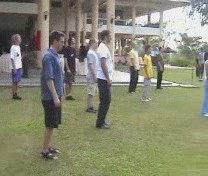
In Shaolin Wahnam, every movement in Shaolin Kungfu and Wahnam Taijiquan is a training of energy and mind. In other works, Shaolin Kungfu and Wahnam Taijiquan are always practiced as chi kung and meditation. This video clip taken at random during the Intensive Shaolin Kungfu Course in Malaysia in November 2004 at the completion of a footwork training session provides an example.
In Shaolin Wahnam, footwork training is also a training of energy and mind. At the end of a footwork training session at the course, students went into chi flow and standing meditation. Sifu Wong is seen encouraging Ismael from Ecuador to flow with the chi. The chi flow movement here is described poetically as “Yew Foong Pai Lau” (Cantonese pronunciation), or “Flowing Breeze and Swaying Willows”, an important kungfu term that is sometimes heard but rarely understood. Sifu Darryl Collett of Scotland, however, is seen enjoying a vigorous and interesting chi flow.
Click here to enter.
Bow-Arrow Stance against Bouncing About
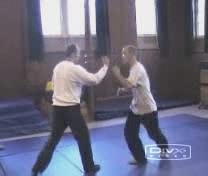
Many people have the wrong impression that stances may be solid but are static. Here Sifu Kai Uwe demonstrates how by shifting the legs skillfully, a kungfu exponent using the Bow-Arrow Stance can be very agile when facing a boxer bouncing about.
Click here to enter.Using Kicks against Boxers

An effective way to fight against a boxer is to use kicks, especially side-kicks. Interestingly, you can almost use side-kick against a boxer irrespective of what moves he makes. Frequently the boxer may not know what to do besides bouncing away, because he has never been trained to counter kicks, as kicks are forbidden in boxing rules.
Click here to enter.
Intercepting a Boxer's Strikes
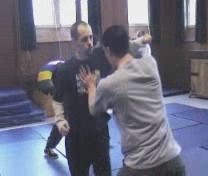
A big mistake many kungfu students make is that when they meet an opponent who fights like a boxer, they discard their own kungfu and fight like a boxer too. This is doubly disadvantageous to them. Here Sifu Kai Uwe Jetkandt shows an example to counter a boxer's attacks. The main pattern used is called “Tame Tiger with Double Bows” in Shaolin Kungfu, or “Jade Girl Threads Shuttle” in Wahnam Taijiquan. Note that while the boxer may become tired easily from his bouncing about, the kungfu exponent is calm and relaxed, and is able to conserve his energy.
Click here to enter.Breakfall
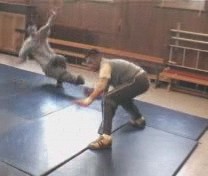
As throws are often used in kungfu, it is necessary for students to know how to break their fall to prevent injury like fracturing their arms or dislocating their elbows. As a student falls to the ground, his palm should be the last, not the first, to hit the ground. If he is untrained he would frequently try to stop his fall with his hand.
This may result in fractures or dislocations. However, breaking falls is not often used in actual combat because by that time kungfu exponent would know how to neutralize or counter the felling techniques of an opponent. It is during the training when they allow their partners to throw them that breaking falls is essential. With this ability it would be difficult to train realistically.
Click here to enter.Rolling
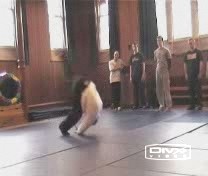
It may be a surprise to some people that throws are often used in kungfu. Hence, students must learn how to avoid being injured when practicing throws. One effective way is to use breakfalls. A better way is to use rolling. In this video clip Sifu Kai Uwi of Shaolin Wahnam Germany teaches participants to a Warrior Project class an effective rolling technique, known in Shaolin Kungfu as “Gourd Rolling on Ground”. It is remarkable that although Sifu Kai Uwi is powerful and solid, he is so agile.
Click here to enter.
Ground Work — Lazy Monkey Watching the Sky

Sifu Kai Uwe of Shaolin Wahnam Germany, who is also an expert in ground fighting, demonstrates some effective groundwork in Shaolin Kungfu to keep an opponent at bay. This Shaolin pattern is known as “Lazy Monkey Watching the Sky”. The video was taken impromptu during a Warrior Project training session.
Click here to enter.
Catching a Monkey
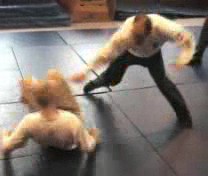
How would you subdue an agile opponent on the ground?. Sifu Kai Uwe demonstrates a method using a Shaolin pattern called “Black Tiger Catches a Monkey”. Laughter is a common feature in our training, including combat training. And laughing at being laughed at is part of our emotional development.
Click here to enter.
Footwork in Meeting Multiple Attacks

Good stances and footwork are essential in meeting multiple attacks. The kungfu exponent must be stable and agile at the same time, manifested as yin-yang harmony. This video shows how a kungfu exponent surrounded by multiple attackers can sense and move using good stances and footwork.
Click here to enter.
Reacting to Attacks from Different Directions
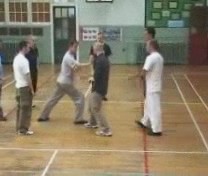
This video shows how to sense and face possible multiple attacks. As attackers move in, use suitable footwork to move agilely to respond to attacks coming from different directions.
Click here to enter.
Defence Footwork in Wahnam Taijiquan
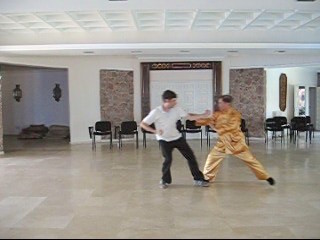
In this video clip, taken during a regional Taijiquan class in Spain in June 2005, shows Sifu Wong and Sifu Javier demonstrating how to move from “Playing the Lute” at left Four-Six Stance and at right Four-Six Stance to “Immortal Waves Sleeves” at right Bow-Arrow Stance.. This is a basic way of meeting an opponent moving in to attack. Notice that in the left-to-right mode, Sifu Wong first moves his front left leg backward, then moves his right leg forward to a desired position. In the right-to-right mode, Sifu Wong just moves his back left leg forward.
Click here to enter.
Attack Footwork in Wahnam Taijiquan — Left to Left Mode

Sifu Wong demonstrates how to move into an opponent to initiate an attack using the left leg to left leg mode. Here he move from a left Four-Six Stance to a left Bow-Arrow Stance. The movement may be in one, two or three steps.
Click here to enter.
Attack Footwork in Wahnam Taijiquan — Left to Right Mode

In this video clip, taken during the regional Taijiquan class in Spain in June 2005, Sifu Wong shows how a Wahnam Taijiquan practitioner may moves into an opponent to initiate an attack, moving from a left Four-Six Stance to a right Bow-Arrow Stance, i.e. from left to right leg mode. The movements may be in one, two or three steps.
Click here to enter.
Moving into an Opponent using Arrow Step
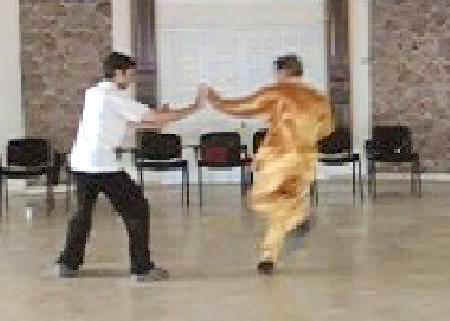
An important way to move into an opponent is called “Arrow-Step”, demonstrated here by Sifu Wong during a regional Taijiquan class in Spain in June 2005. Arrow-steps may be implemented from any stance to any stance. Here Sifu Wong “shoots” out the “arrow-steps” from a Four-Six Stance to a Bow-Arrow Stance. He demonstrates all the four major leg modes, namely from left-to-left, from left to right, from right to left, and from right to right.
Click here to enter.
Right and Wrong Ways to Yield in Wahnam Taijiquan

Yielding is an important aspect in Taijiquan, but it should be done correctly. If it is done wrongly, not only it fails to achieve its purpose, it may give away technical advantages to the opponent. In this video, taken during a regional Taijiquan class in Spain in June 2005, Sifu Wong and Sifu Javier first shows a wrong way, and then a right way to yield when using “Immortal Waves Sleeves” against an opponent's charging attack. When yielding is done wrongly, the practitioner is caught in an awkward position. But when it is done correctly, the practitioner turns the opponent's momentum back against himself.
Click here to enter.
Transition from Pre-Arranged to Free Sparring — Part 1
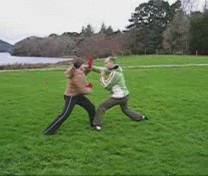
Many martial art students today make a big mistake thinking that free sparring is the way, often the only way, to learn how to fight. In all kungfu history, this was not so. Going straight to free sparring without systematic preparation is a sure way to fight like children. There are a few progressive steps between set practice and free sparring.
Pre-arranged sparring as shown by Mark and Simon in Combat Sequences 5 to 8 and Combat Sequences 9 to 12 is one of these steps. Having familiarized themselves with the appropriate skills and techniques to meet typical combat situations, students progress to a series of transitional stages where control over pre-arranged patterns is gradually released.
One effective method we use in Shaolin Wahnam to achieve this purpose is what we call “Addition and Subtraction”, as shown in this video clip taken impromptu when Nicky and Hubert (both from Shaolin Wahnam England) practiced sparring on a windy winter morning by the side of beautiful Lake Killarney in Ireland in February 2005.
Is the sparring free or pre-arranged? It depends on the stage of development. The method can be programmed to range from totally pre-arranged at a beginners' stage to totally free at an advanced stage. This video clip shows the beginners' stage, where only some of the movements are free.
Click here to enter.
Transition from Pre-Arranged to Free Sparring — Part 2
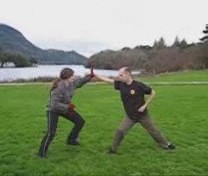
This impromptu video clip shows Nicky and Hubert practice sparring on a windy, winter morning in Ireland in February 2005. Is their sparring free or pre-arranged? It is neither, or either. Nicky and Hubert are in the process of transition from pre-arranged to free sparring. At the stage shown in the video clip, about 70% of their sparring is pre-arranged and 30% free. It is a progression from the stage shown in Part 1
in another video clip where only about 10% is free. Systematically releasing the control of random movements is a key factor in training students to free spar or fight effectively using typical kungfu skills and techniques. The training method used here, called “Addition and Subtraction” by us in Shaolin Wahnam, is excellent for this purpose.
It overcomes two big problems faced by many kungfu practitioners, namely how to implement a series of selected techniques efficiently as an attacker, and how to defend against or counter a series of attacks coming at you randomly as a defender. Nicky and Hubert are doing remarkably well here. They have practiced Shaolin Kungfu for only nine months!
Click here to enter.
Transition from Pre-Arranged to Free Sparring — Part 3

In this video clip Nicky and Hubert have progressed further in their transition from pre-arranged to free sparring. Not only they have increased the percentage of random movements, they also have added kicking attacks. Those who are familiar with our Shaolin Wahnam Combat Sequences will notice that the kungfu patterns chosen for sparring in Part 1 are from Sequences 1 to 4, those in Part 2 from Sequences 1 to 8, and those in this video clip, Part 3, from Sequences 1 to 12.
Notice that Nicky uses a correct kicking attack, but her spacing is incorrect. Hubert rightly suggests that a side kick, rather than a thrust kick, would be more effective in that situation, and later he attempts one too. Hubert's kicking attack as well as his second one later on are random moves.
It is worthy of note that Nicky is more efficient in her counter against Hubert's side kick the second time than the first, confirming that when you have worked out a counter once, subsequent counters to similar attacks would be easier, which is an important principle underlying systematic combat training.
Click here to enter.
Sparring Practice at Shaolin Wahnam Switzerland — Part 1
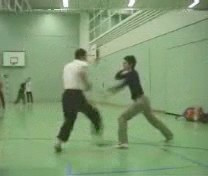
This is a sparring session at Shaolin Wahnam Switzerland, taught by Sifu Andrew Barnett. Those who have seen a few of our video clips on sparring may wonder why they look similar, regardless of whether they were taken in Switzerland, Ireland, Canada, Germany, Costa Rica or elsewhere.
The answer is straight-forward. Of course they are similar because they all come from the Shaolin Wahnam Sparring Methodology. In fact this reflects an important point we have been advocating, i.e. those trained in kungfu should spar or fight using kungfu, not using Karate, Kickboxing or any other martial arts.
To go a step deeper, those trained in Shaolin Kungfu or Taijiquan would spar or fight using Shaolin Kungfu or Taijiquan, not using Pak Mei Kungfu or Baguazhang. To go even deeper, those trained in Shaolin Wahnam (whether in Shaolin or Taijiquan) would spar or fight using the skills and techniques learnt in Shaolin Wahnam. This leads to another question.
Can those trained in other schools or systems benefit from watching video clips on Shaolin Wahnam Sparring Methodology? Of course they can. They may, for example, apply the principles explained or shown on our video clips to their own styles or systems. They may, for example, learn how to use their own techniques for defence, instead of merely punching and kicking wildly. The principles are the same, but the sparring will be different because they use the techniques of their own schools or systems.
Click here to enter.
Sparring Practice at Shaolin Wahnam Switzerland — Part 2
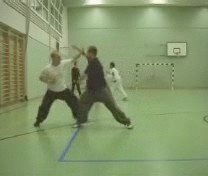
Here is another sparring session at Shaolin Wahnam Switzerland . Interestingly, this impromptu video clip filmed during a regular class taught by Sifu Andrew Barnett, exemplifies a fact that many kungfu students may have read but find it hard to believe, namely a master with internal force may floor an attacker simply by warding off his attack.
At the start of the video clip, a female student attacks Sifu Andrew Barnett with “Black Tiger Steals Heart”. Sifu Andrew Barnett responds with “Dark Dragon Draws Water”, which is found in Sequence 6 of our Shaolin Wahnam Sparring Methodology. Although Sifu Andrew Barnett controls his attack, the attacker falls onto the ground, not due to his attack but due to the force of his other defending hand, albeit purposely reduced under his control.
The sparring shown in this video clip is similar to that shown in other video clips. This is because the practitioners train the same type of kungfu and employ the same sparring methodology. In other words, anyone using the Shaolin Wahnam Sparring Methodology correctly would be able to spar like those shown in the video clips, i.e. using typical kungfu techniques and skills — and not using Kickboxing techniques or bouncing about like Boxers.
Similarly anyone using an appropriate sparring methodology in Taijiquan, Hoong Ka, Wing Choon, Praying Mantis or any kungfu style would be able to spar and fight using his own style. Such sparring methodologies were used in the past, but today they are extremely rare. So if you wish to spar using your own kungfu style, you have to find out an appropriate sparring methodology, or, albeit a poor alternative, work one out yourself. Hopefully, our video clips will provide you with some help.
Click here to enter.
Combat Sequences from Dragon Style Set — Part 1
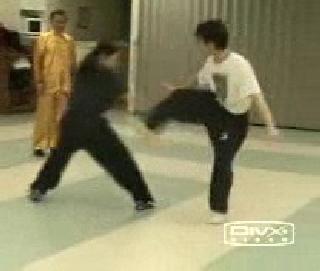
How are combat sequences composed? They are composed from combat situations, and then are gradually improved upon as the exponents progress to higher levels. These series of video clips taken impromptu at the Special Shaolin Kungfu Course in Toronto in 2004 show how this happened.
This video clip shows the transition from the basic combat sequences to more sophisticated combat sequences. The sequence shown here is similar to Combat Sequences 1 to 12, except that at appropriate places Emiko and Michael use patterns from their specialized set, Dragon Style, rather than from the basic sets.
For example, instead of using “Black Tiger Steals Heart” and “Single Leg Hand Sweep”, Michael uses “Green Dragon Shoots Pearl” and “Dragon Expresses Marvelous Powers” instead. The last pattern in the video clip, “Phoenix Nods Head” is a progression, and how this comes about is revealed in another video clip.
Click here to enter.
Combat Sequences from Dragon Style Set — Part 2
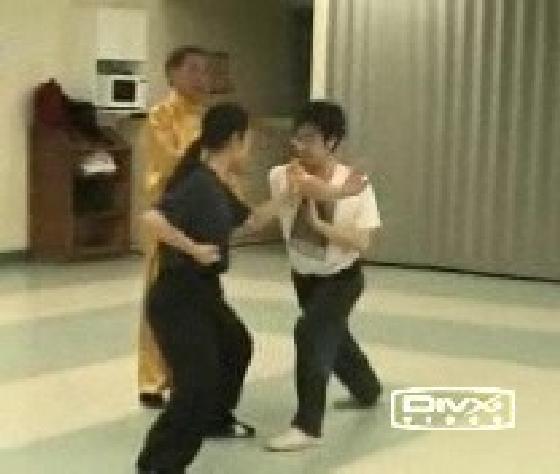
This video clip shows a progression from the previous video clip where Emiko and Michael incorporated patterns from their Dragon Style Set into the combat sequence.
Here Sifu Wong shows Michael a more advanced way to implement the pattern “Green Dragon Shoots Pearl”, which speeds up the counter attack. This principle is expressed as “big forms for training, small forms for combat.”
Click here to enter.
Combat Sequences from Dragon Style Set — Part 3
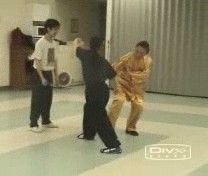
After having used appropriate patterns to overcome various combat situations that were not pre-arranged, Emiko and Mike go over the sequence again, this time improving on their choice of patterns. Then they go over the improved sequence, which now incorporate better techniques, explaining the philosophy behind the choice of their patterns.
Sifu Wong gives his advice wherever appropriate. Here Sifu Wong shows Michael how to use a more advanced counter from the Dragon Style Set, “Phoenix Nods Head”, against Emiko's “Hang a Golden Star”. Sifu Wong also explains the two progressions involved, first using two steps then progressing to one step, which is an improvement of tactics.
Click here to enter.
Combat Sequences from Dragon Style Set — Part 4

As Emiko and Michael work on the sequences, Sifu Wong shows how they can improve both the techniques as well as the tactics in combat. An example each can be found in Part 2 and Part 3 of this Dragon Style series.
In this video clip Sifu Wong shows the progression from big movements in practice to small movements in combat using the pattern “Green Dragon Shoots Pearl” as an example, and how a skillful exponent may exploit the weakness of an opponent making a big movement.
Hence, by working on the combat sequences which they themselves have composed from their specialized set, Emiko and Michael have progressed remarkably from the basic level of combat sequences 1 to 16, to more advanced levels where a greater variety of skills and techniques are used.
Click here to enter.
Chi Flow after Combat Application

Besides breath control, another crucial factor that enables Shaolin Wahnam members to spar for hours without feeling out of breath is their ability to conclude their training, or a part of the training, with chi flow. Such chi flow loosens their muscles, clears away toxic waste, restore their normal heart beats, calms their mind, and replenished their energy spent.
This impromptu video clip taken at the five-day regional Taijiquan course at the Shaolin Wahnam Centre in Costa Rica shows course participants go into a chi flow immediately after sparring practice where they employ side-kicks against Boxers' attacks.
Click here to enter.
Application of Tiger Claws

In this video clip Sifu Wong shows Eugene and David an application if the Double Tiger Claws from their specialized set, “Tiger-Crane Set”. During such practice, sometimes the exponents may slow down or temporary stop their movements to think. One may ask whether slowing down to think will give an opponent time to strike, or whether this contradicts the tenet that an effective fighter does not think while fighting.
These questions indicate a failure to appreciate that sequence training is not free sparring or real fighting — it is a preparation to free sparring and real fighting. In fact in this case Sifu Wong asks Eugene and David to purposely slow down their movements. But when they have been systematically and sufficiently trained, they can free spar or fight spontaneously without thinking.
Click here to enter.
Application of Crane Beak
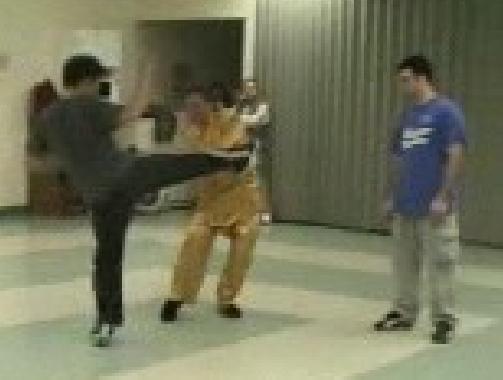
Eugene and David are working out some combat sequences of their own using patterns from their specialized set, “Tiger-Crane”. They have to explain the reasons or philosophy for the choice of their patterns, like why one particular pattern is superior to another in a given combat situation, or what modification is needed if the situation is different. Here Sifu Wong explains to Eugene and David various ways to use a Crane Beak to neutralize a powerful kick, instead of blocking the kick head-on.
Click here to enter.
